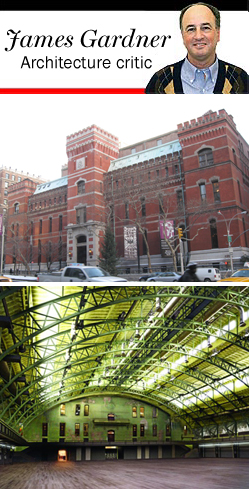
From left: Park Avenue Armory and a rendering of its renovated interiorThe Park Avenue Armory, which takes up the entire east side of Park Avenue between
66th and 67th streets, has just announced plans for a $200 million renovation of the site. This news
is wonderful, but hardly unexpected. It has been quite clear for some time that this former military
structure was meant for better things.
What is remarkable about the 643 Park Avenue structure’s resurrection — for it is nothing less than that — is that the
building represents a typology that, like an abandoned bank or a deconsecrated church, would seem
ill-suited to any function other than the one for which it was originally intended, a function no longer
needed. The building, designed by Charles Clinton in the Gothic Revival style and opened in 1881,
consists of a five-story front section along the avenue and, behind it, a cavernous 55,000-square-foot
enclosed area, known as the Wade Thompson Drill Hall.
As so often in New York City in recent years, what originally served a serious “grown-up” function — banking, troop deployment, etc. — has been reborn as a quasi-ludic cultural venue. The drill hall
especially has become a center for exhibiting the sort of maximalist visual art projects and live
performances, that could not fit in many other spaces around the city. Among these are Christian
Boltanski’s “No Man’s Land” installation and, more recently, Peter Greenaway’s inventive recreation
of “Leonardo’s Last Supper.” The space has also served as the venue for the Royal Shakespeare
Company and for Merce Cunningham’s dance company. It has also been the preferred context for
various high-profile art and antiques fairs.
It was announced this week that the ineffably arty Swiss firm of Herzog & de Meuron would tactfully
touch up the entire space, including not only the drill hall but also the sequence of sumptuous period
rooms — designed by the likes of Louis Comfort Tiffany and Stanford White — that grace the front of
the building. This firm is most famous for its similar transformation of an old power plant into London’s
Tate Modern, as well as, more locally, the creation from scratch of Ian Schrager’s 40 Bond Street. Their latitude for invention in this case seems somewhat limited. Although the drill hall will get
some post-modern metallic touches along the roof, most of the period rooms will simply be spruced up
in accordance with the original intention of their design. The new improved armory will also include new
performance and rehearsal spaces.
On a personal note, I am especially gladdened by this transformation, which will occur over the next two
years. As a child growing up in New York, I went to the Armory every Tuesday and Friday from the age of
8 to 13 as a proud member of the Knickerbocker Greys, an after-school program that allowed boys, and
now girls, to march around the drill hall with rifles (dummies of course) as well as swords and eventually
sabers. At the time, around 1970, the place seemed haunted and indescribably ancient. Now it promises
to be reborn as one of the most vibrant and youthful places in the five boroughs.